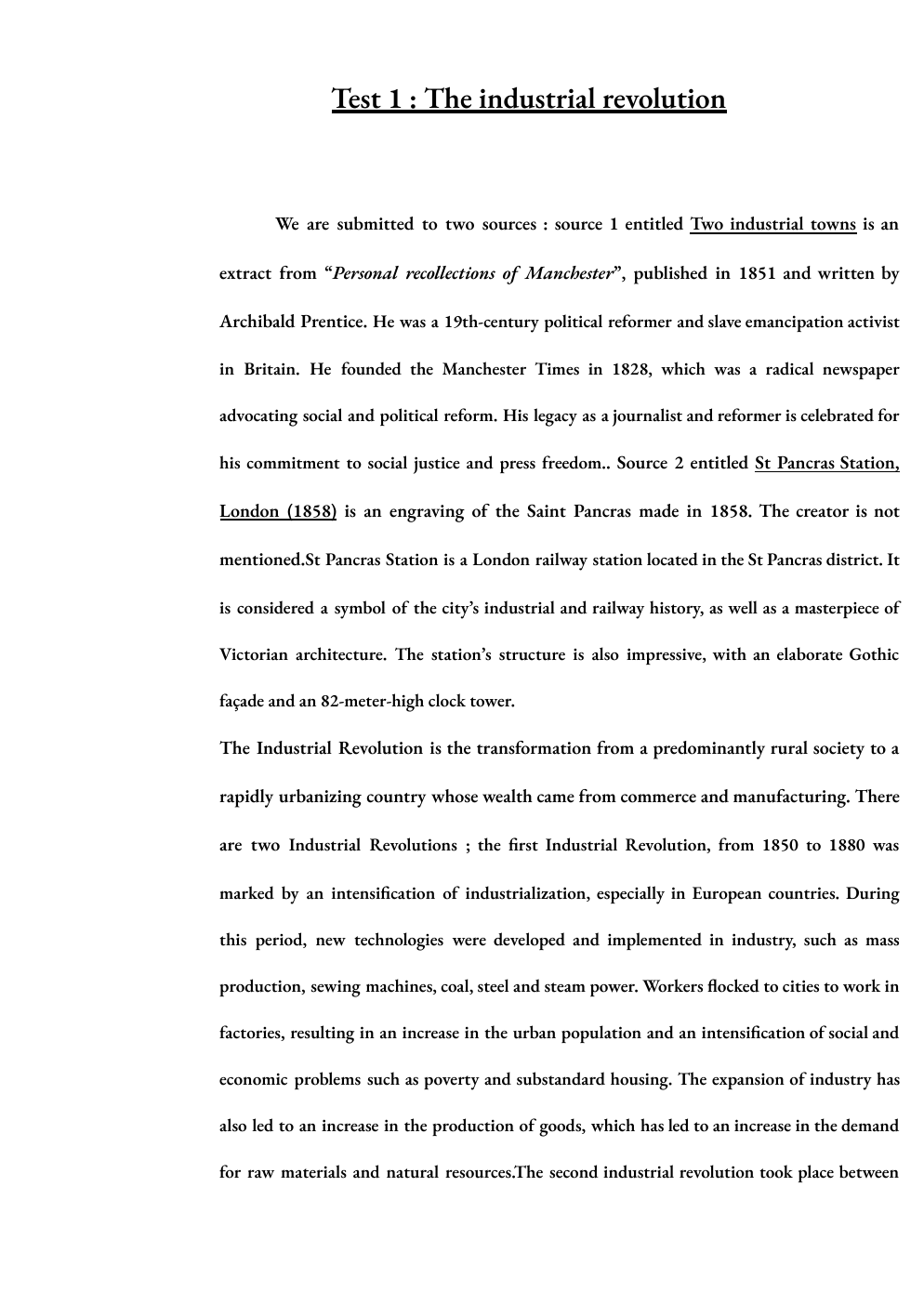the industrial revolution
Publié le 02/05/2024
Extrait du document
«
Test 1 : The industrial revolution
We are submitted to two sources : source 1 entitled Two industrial towns is an
extract from “Personal recollections of Manchester”, published in 1851 and written by
Archibald Prentice.
He was a 19th-century political reformer and slave emancipation activist
in Britain.
He founded the Manchester Times in 1828, which was a radical newspaper
advocating social and political reform.
His legacy as a journalist and reformer is celebrated for
his commitment to social justice and press freedom..
Source 2 entitled St Pancras Station,
London (1858) is an engraving of the Saint Pancras made in 1858.
The creator is not
mentioned.St Pancras Station is a London railway station located in the St Pancras district.
It
is considered a symbol of the city’s industrial and railway history, as well as a masterpiece of
Victorian architecture.
The station’s structure is also impressive, with an elaborate Gothic
façade and an 82-meter-high clock tower.
The Industrial Revolution is the transformation from a predominantly rural society to a
rapidly urbanizing country whose wealth came from commerce and manufacturing.
There
are two Industrial Revolutions ; the first Industrial Revolution, from 1850 to 1880 was
marked by an intensification of industrialization, especially in European countries.
During
this period, new technologies were developed and implemented in industry, such as mass
production, sewing machines, coal, steel and steam power.
Workers flocked to cities to work in
factories, resulting in an increase in the urban population and an intensification of social and
economic problems such as poverty and substandard housing.
The expansion of industry has
also led to an increase in the production of goods, which has led to an increase in the demand
for raw materials and natural resources.The second industrial revolution took place between
1881 and 1910.
The main innovations of this period include the invention of electricity,
telephone, car, aircraft and oil.
These innovations have resulted in even larger and more
efficient production of goods, which has led to an expansion of industrial production and
unprecedented economic growth.
Workers were exposed to even greater risks in factories and
mines, and trade union movements began to develop to defend workers' rights.
The
provenance of both documents is not mentioned.
These two documents seem to deal with the Industrial Revolution ; to what extent do they
illustrate it ? Firstly, we will analyze the sources and secondly, we will be able to explain how
these documents exemplify the Industrial Revolution.
However, the 19th century marks the
glass industry by the importance of technical advances allowing the organization of massive
productions thanks to machines allowing a considerable increase in productivity.
The same
applies to iron :
In the first document, Archibald Prentice describes the city of “Manchester” (lines 2, 5
and 9) in his lifetime.
Born in 1792 in Edinburgh, Scotland, he studied law at the University
of Edinburgh and then moved to Manchester to practice law, where he founded the
Manchester Times in 1828, which was a radical newspaper advocating social and political
reform.
The newspaper was the first to cover political meetings and public events using
reporters rather than official reports.
Until then we can say that what he shows us in his work
is a faithful representation of reality.
It begins by evoking the "volumes of smoke which
continually issue from factory chimneys" line 1 and the “chemical works and great engineering
factories” line 6.
It is known that the first industrial revolution is characterized by an
intensification of industrialization and that coal was one of the....
»
↓↓↓ APERÇU DU DOCUMENT ↓↓↓
Liens utiles
- Industrial Revolution I INTRODUCTION Industrial Revolution, widespread replacement of manual labor by machines that began in Britain in the 18th century and is still continuing in some parts of the world.
- Oliver Cromwell I INTRODUCTION Oliver Cromwell (1599-1658), leader in the English Revolution (1640-1660) and the first commoner to rule England.
- Galileo I INTRODUCTION Galileo (1564-1642), Italian physicist and astronomer who, with German astronomer Johannes Kepler, initiated the scientific revolution that flowered in the work of English physicist Sir Isaac Newton.
- Napoleon I I INTRODUCTION Napoleon I (1769-1821), emperor of the French, whose imperial dictatorship ended the French Revolution (1789-1799) while consolidating the reforms it had brought about.
- English Revolution I INTRODUCTION English Revolution, also called the Puritan Revolution, general designation for the period in English history from 1640 to 1660.







